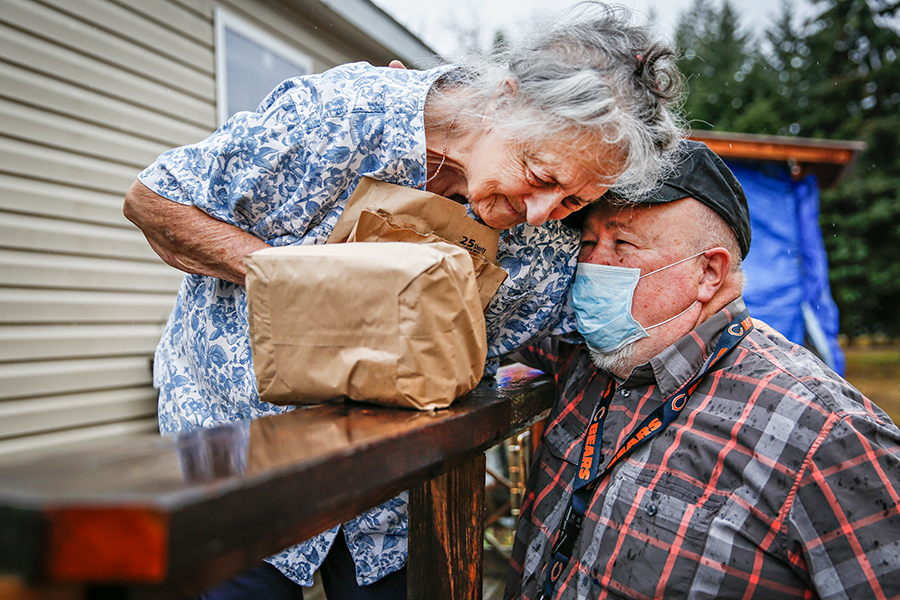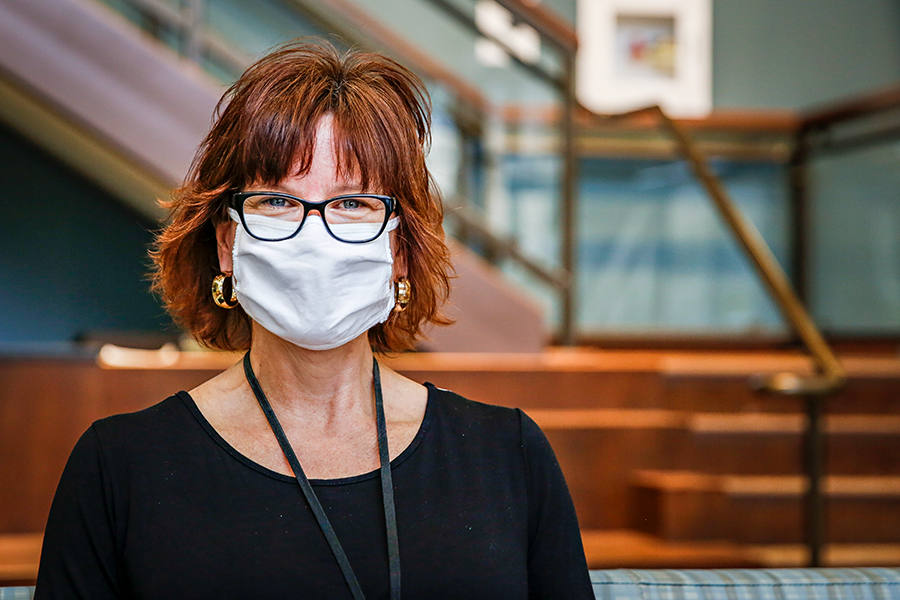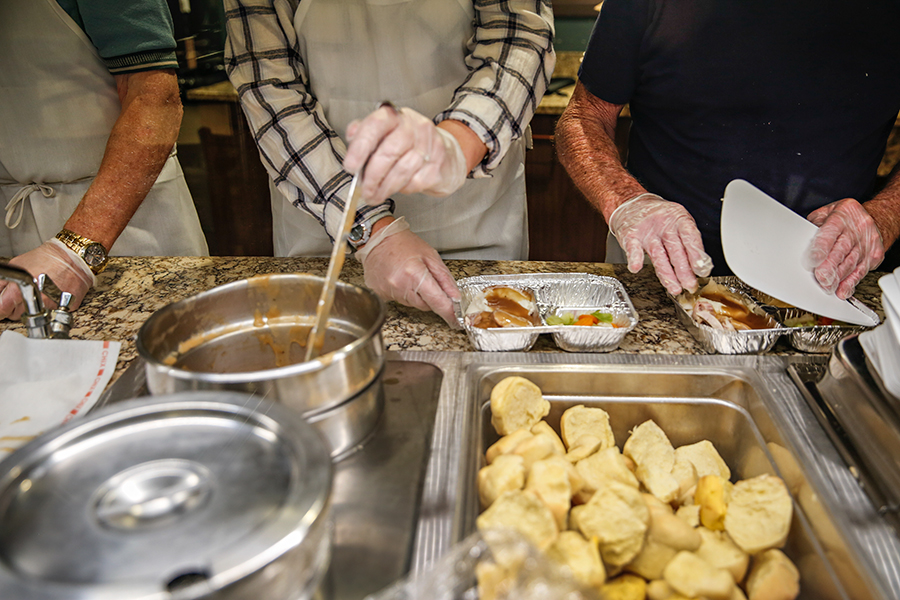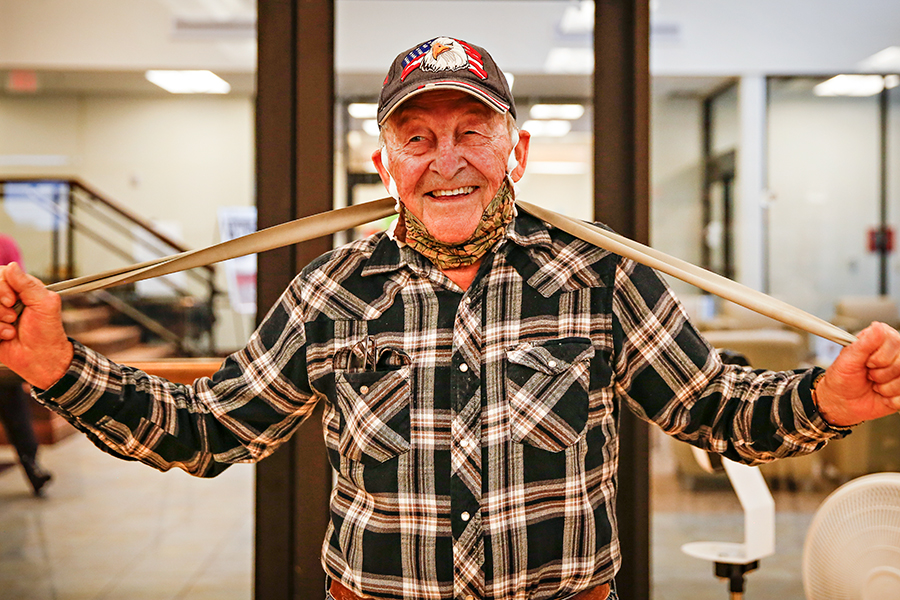The Fight Against Isolation
With a large local elderly population split between sheltering at home and seeking social activities, how does the community keep independent seniors safe from COVID-19 while maintaining their spirits and the rest of their wellbeing?
By Myers Reece
Seniors are uniquely predisposed to pandemic threats: they are the most vulnerable population to severe COVID-19 complications, but many are already at risk of isolation-inflicted problems, mental and physical. Social distancing inherently weakens social networks, with magnified consequences for the elderly, while introducing dilemmas such as increased reliance on digital communications and a burgeoning illicit market of scammers preying on seniors.
How do you simultaneously keep independent elderly residents safe from the virus while maintaining their spirits and the rest of their wellbeing?
Local senior advocates, from the Flathead County Agency on Aging (AOA) to the Kalispell Senior Center to My Glacier Village, have navigated that question since March, compiling a collection of strategies and insights along the way in a county where one-fifth of the population is older than 65.
The intersection between those worries and advocates’ efforts to mitigate them was apparent on a recent meal delivery trip to Rodessa Norton’s house in Evergreen. J.R. Isles, who heads up the AOA’s Meals on Wheels program, and his grandson Jordan, a volunteer, arrived at Norton’s home with her meal: hot pork roast on a rainy November day.
Norton, eager to see a visitor, brushed off the program’s social-distancing protocol and swooped in for hugs.
“I’m so glad you came!” an emotional Norton exclaimed. “I love to see you guys. Thank you for caring.”
Isles said Meals on Wheels delivery volunteers are the only people some homebound residents see with any regularity, and volunteers at times are the source of welfare-check calls. Other seniors, however, are considerably more social and involved in the community, speaking to the range of pandemic reactions among independent seniors.
Representative of the community and country at large, seniors land along a broad spectrum of COVID-19 worry, from unconcerned to terrified, but the realities of the disease’s deadly effects on the elderly underlie the risk-reward calculations for seniors deciding whether to have social circles, and how big and with whom, including those who have nixed face-to-face interactions even with immediate family. Some Meals on Wheels recipients ask for food to be hung on their doorknob to avoid any contact.
No matter their level of concern, seniors have all dealt with significant disruptions in their lives, an abrupt shift in daily paradigms that can be more destabilizing for an 85-year-old than a 25-year-old.
“All of a sudden their entire world changed with COVID,” AOA Director Lisa Sheppard said. “What might have been inconvenient or difficult before became impossible: getting their groceries or prescriptions, routine health care or socializing. Everybody’s world got pretty shaky.”

The AOA, the cornerstone aging-service provider for the region, conducted a survey earlier this year to get older adults’ feedback about living in the pandemic. Asked about their biggest concerns during the stay-at-home order, respondents’ top three answers were “health and wellbeing of family or friends,” “lack of social connection” and “catching the virus.” Also high on the list were scarcity of supplies such as toilet paper and face masks, lack of physical activity and “loneliness, anxiety or depression.”
“They were conscious of, and worried about, their own inability to socialize, their own isolation, their own loneliness and the resulting depression and anxiety from that,” Sheppard said. “The level of self-awareness around that but with very few avenues to address it really jumped out at us.”
After the stay-at-home order was lifted, many seniors continued sheltering in place, and advocates say that number increases as cases do, which is currently happening amid a COVID-19 surge in Flathead County. While public-health officials warn that pandemic fatigue has led many in the community, including some seniors, to drop their guard, the elderly are more likely to remain as vigilant as ever, resulting in a months-long heightened awareness that can exacerbate feelings of loneliness and anxiety.
There’s also the issue of fewer social opportunities available even to those who seek them. For instance, the AOA’s dining room in Kalispell, which used to host nearly 100 people daily for lunch and post-meal activities such as cribbage, has been shut down for months.
“Isolation is a problem we’re running into,” Isles, the AOA’s nutrition program manager, said. “This was their life, and now they can’t do anything or go out. I feel bad for them.”
Demand for the Meals on Wheels program has skyrocketed, propelled by a combination of more seniors staying home, the dining room’s closure, unease about grocery shopping and loss of access to caregivers due to concern over virus exposure. Meals on Wheels, perhaps the best-known program of the multi-faceted AOA, has added delivery routes and recently put out a call for more volunteer drivers.
“Our numbers keep climbing so fast,” Isles said. “We need volunteers.”
Isles noted that most volunteers are over 60, braving both winter roads and their own higher-risk status for a community cause.
“They amaze me,” Isles said. “To me, they are heroes.”
The Meals on Wheels program is sending out 400 hot meals a day from its expansive kitchen at Flathead County’s south campus building in Kalispell, while giving volunteer drivers an additional 200 frozen meals every Friday to distribute for weekends. The program is on pace to serve 100,000 meals this year, a huge increase even with the closure of the dining room.
The increased demand has led to a tightening budget, and Sheppard noted that a lot of the new recipients would have qualified for meals even before eligibility guidelines were loosened amid the pandemic. If they remain with the program, as many will likely do, the long-term financial outlook could be thorny, particularly considering that the state is facing “significant revenue shortfalls,” according to Sheppard.
“What that might mean for our programs we don’t quite know, but we’re bracing for cuts,” Sheppard said. “We still have CARES Act funding right now to cover this increase in demand, but we’re really concerned looking into the future over how we’re going to meet increased demand given the uncertainty over federal funding but in particular state funding.”

More immediately pressing, COVID-19 has diminished fundraising opportunities, and Isles says the budgetary situation will grow more difficult if cases don’t decline.
“If COVID keeps climbing, we’re going to be getting really slammed,” Isles said.
In addition to Meals on Wheels, the AOA offers an extensive lineup of services to older adults, including assistance with Medicare and enrollment, benefits information, veteran direct care, in-home services, caregiver support, help with navigating community resources and more.
As more seniors stay home, more spouses and children have suddenly found themselves in the caregiver role, or existing caregivers have acquired increased responsibilities, and Sheppard said her agency has made a concerted effort to reach out to caregivers, who often fly under the service radar.
“Anything we can do to support them, we want to,” she said. “But we have to find them.”
Services have shifted more online and over the phone than in-person, which raises technology-literacy questions among a number of seniors. Moreover, digital has increasingly replaced in-person as the primary mode of conversation with loved ones, which can present technological obstacles and simply feel inadequate.
“I think it’s really hard to find a substitute for in-person interaction,” Sheppard said. “You can talk on the phone, you can FaceTime, you can Zoom if you have the capability, but I do think people really miss the in-person connection and have in many cases decided to take the risk to have that in-person connection. Hopefully they’re wearing masks and social distancing when they do those things.”
Aging-service providers also promote education to help seniors guard against fraud, a prevalent concern in general but particularly during the pandemic. The AOA distributes a pamphlet from the state Department of Public Health and Human Services about COVID-19 scams that warns: “protect yourself from more than the virus.”
Common scam topics include Social Security, Medicare and Medicaid, grocery delivery, charity, fraudulent COVID-19 vaccines or cures, and pandemic-specific supplies such as masks and disinfectant wipes.
Like the AOA, other senior-advocate organizations have adapted to meet the needs of seniors. Jenn Prunty, the cofounder of My Glacier Village, a nonprofit that supports independent seniors in the community, said her volunteer-driven operation embraces members’ wide range of pandemic lifestyles, including a growing number of people sheltering in place but also others remaining socially active.
“People are doing COVID differently, and we’re trying to accommodate everyone,” Prunty said. “The bottom line is we’re helping people create their new normal moving forward. Just like every industry in the world is having to adapt, we’re no different. But what we do and what matters more now than ever is connection.”
My Glacier Village is less a service provider than a peer-to-peer network, providing social outlets while also assisting with tasks such as shoveling snow and rides to medical appointments, and simply watching out for each other. The nonprofit holds social gatherings with COVID-19 safety protocols but is also embracing digital communications, including the use of iPads to strengthen members’ technology prowess.
“We’re trying to help them get comfortable with technology, to take the fear out of it, but if they don’t want to, that’s OK,” Prunty said.
Linda McDevitt, a volunteer with the nonprofit, was worried about her 92-year-old friend, whose cognitive functioning and energy levels were suffering amid the dearth of social outlets and isolation. So McDevitt invited her to activities hosted by My Glacier Village.
“She was happy to meet people, and I just saw her really perking up,” McDevitt said. “She’s definitely more alert and more connected with friends, connected with the world.”
“Isolation is far more deadly than we give it credit for being,” she added. “It really takes a toll.”

The Kalispell Senior Center closed early in the pandemic but later began reintroducing limited activities at various locations to accommodate social distancing, including summer exercise classes in the parking lot of the Elks Lodge, which drew supportive honks from motorists on U.S. Highway 93.
The center now offers socially distanced activities five days a week, including yoga, aerobics, dancing and Qigong classes at its activity room in the Flathead County south campus building, in addition to art classes. The center also hosts weekly bingo at the fairgrounds, which provides a space large enough for players to safely spread out from each other. Strict sanitization protocols are in place.
“Everyone is really conscientious,” said Gerri Backes, president of the senior center’s board. “We’ve spent a small fortune on hand sanitizers, but it’s been going great. We’re really blessed that we’re able to reach out to the members.”
Backes said a lack of activities affects the elderly in myriad ways: cognitive, sense of balance, mental health.
“When activities started back up, a lot of them had brain fog and couldn’t remember things,” she said. “It enhances every aspect of their wellbeing, but it’s also a reason to get up in the morning.”
Nicholas Stein, an 83-year-old U.S. Navy veteran, was a devoted attendee of Kalispell Senior Center activities before the pandemic shut the center down in the spring. Determined not to let the lockdown hurt their health, Stein and his wife would crank up music in their home, grab weights and exercise.
But the makeshift home exercise classes couldn’t satisfy the Steins’ need for socialization. When the center started offering activities again, albeit diminished and with strict precautions, the Steins jumped at the opportunity and have been faithful regulars since.
“I went to my doctor and he said keep up that exercise; it’s better than any pill,” Nicholas Stein said, adding: “We’re very aware that some of us have health issues. Being a Christian, I have faith we’ll get through this.”
Backes also tells the story of a man who lost access to his beloved piano when the social area of his senior-living community closed. The Kalispell Senior Center board granted him special permission and gave him a key to its activity area, where he can periodically be found happily playing piano.
“He said, ‘It’s my salvation,’” Backes said.
Backes said about half of senior center members who attended activities before the pandemic “have opted to wait things out.” Some of them have contact with grandkids and are worried about contracting the virus and unwittingly introducing it to fellow members, as Backes notes that transmission among family gatherings is a primary culprit in spread.
While Backes said rising cases don’t offer a rosy outlook and lead to increased stress among members, she is pleased that the center can offer critical social outlets, boosting both mental and physical health, in a time of great uncertainty.
“If we can get someone to smile, even just one smile a day, or to laugh,” Backes said, “that’s therapy.”